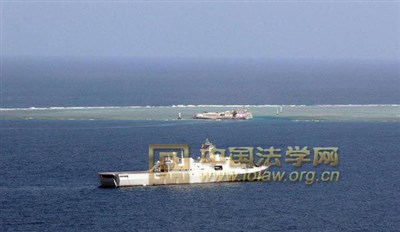(China Daily)
http://www.chinadaily.com.cn/opinion/2016-05/06/content_25099507.htm
Updated: 2016-05-06 08:11

A formation of the Nanhai Fleet of China's Navy on Saturday finished a three-day patrol of the Nansha islands in the South China Sea. [Photo/Xinhua]
On Oct 29, 2015, the Arbitral Tribunal constituted under Annex VII to the United Nations Convention on the Law of the Sea in the arbitration instituted by the Philippines against China rendered its award on jurisdiction and admissibility. The tribunal concluded that it does have jurisdiction over the matters raised in seven of the Philippines' claims.
On Oct 30, the Chinese Foreign Ministry issued a statement saying the award is null and void, and that it has no binding effect on China. Subsequently, the Chinese government reiterated that it will neither participate in nor accept the arbitration initiated by the Philippines.
It is important to note how the tribunal reached the conclusion. Let us analyze the award from the evidence perspective, which clearly shows what the arbitrators were concerned with and what their contemplation and reasoning yielded.
First, a general problem of evidence in the arbitral proceedings is that all the evidence was produced by the Philippines unilaterally. International tribunals' fact-finding process is different from national ones, that is to say, what kind of evidence a tribunal can get depends on the willingness of the parties. It is up to the parties to produce whatever evidence they consider useful to their claims.
A party is not obliged to provide anything adverse to its claims to the adjudicative body. In the proceedings in question, the Philippines submitted to the tribunal piles of documents, files, figures and maps, which added up to 3,700 pages, to justify its claims. The five arbitrators would not have been able to access, interpret and evaluate this huge pile of material unilaterally produced by the Philippines in a limited period of time.
Second, there were other specific problems of evidence in the arbitral proceedings, one of which was the irrelevant set of evidence presented by the Philippines. The tribunal examined four Notes Verbales as evidence. They included China's two Notes Verbales, Nos CML/17/2009 and CML/18/2009 of May 2009, addressed to the UN secretary-general, and their contents were the same.
The other two were the Notes Verbales, Nos 000228 and CML/8/2011, from the Philippines and China to the UN secretary-general. The tribunal ignored the backgrounds of these Notes Verbales, which were very complicated.
Take Notes Verbales Nos CML/17/2009 and CML/18/2009 for example. Malaysia and Vietnam issued a joint submission to the Commission on the Limits of the Continental Shelf regarding the outer limits of the continental shelf beyond 200 nautical miles on May 6, 2009. Vietnam issued a separate submission to the same commission on the same issue the next day. China presented its position to the UN secretary-general on May 7, 2009. That is the background of the two Notes Verbales.
Accordingly, Note Verbale No CML/17/2009 is the response to the joint submission by Malaysia and Vietnam, while Note Verbale No CML/18/2009 is the response to only Vietnam's submission. The receiver of these two Notes Verbales is not the Philippines, so they are not relevant to the arbitration instituted by Manila. Worse, the tribunal did not examine the two Notes Verbales that were relevant to the parties (Nos 000228 and CML/8/2011) in their entirety. For instance, the tribunal neglected the preface and the first paragraph of Note Verbale No 000228, and only quoted the second and third paragraphs.
Third, another specific problem is that some of the evidence is inadmissible. In judicial practice, evidence obtained through settlement negotiations can be problematic. This is the problem with some bilateral consultation records submitted by the Philippines. These sets of evidence are internal and unilateral records, whose weight of proof can be questioned without the two parties' signatures.
Fourth, according to information available on the Permanent Court of Arbitration's website, there are possible problems of evidence in the merits decision. For example, it is not easy to evaluate the scientific and technical evidence for the tribunal.
To prove some maritime features are low-tide elevations, counsel for the Philippines collected and showed lots of hydrologic, geographical and historical data, and two reports from Kent E. Carpenter, a professor at Old Dominion University in Virginia, US. When these sets of evidence were raised, the Philippines' counsel were dumbstruck by the sharp questions from the tribunal about the facts and proof value of these sets of scientific evidence. The problem with Carpenter's reports is that they were made after the Philippines initiated the proceedings. The relevance and reliability of the reports therefore are questionable.
On the other hand, the other expert witness, Clive Schofield, director of research at Australian National Centre for Ocean Resources and Security, University of Wollongong, New South Wales, Australia, changed his views at the arbitral proceedings. What he said as an expert before the tribunal was totally different from what he had written. Can these experts' statements become the authoritative and valuable evidence for the tribunal?
We strongly suggest the tribunal reconsider the objectivity and neutrality of the statement given by Schofield. It should also be emphasized that many academic papers were also presented at the merit hearing, but academic papers only represent personal viewpoints and cannot be used as evidence in disputes.
Accordingly, several issues have arisen from the use of evidence by the tribunal and the merit decision. The tribunal deliberately framed the Philippines' evidence in a favorable way, thus making the award questionable.
The author is an assistant professor at the Institute of International Law of the Chinese Academy of Social Sciences.